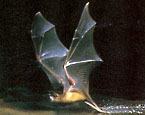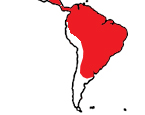|
Greater
Bulldog Bat
(Noctilio leporinus) |
||||
|
|
Physical
characteristics and distribution
|
|
The
larger of only two species of the genus Noctilio, N. leporinus
has a head and body length of 98-132mm and forearm length of
72-92mm. Weights are from 60-78 grams, with the males heavier
than the females. Coloration is gray or dull brown along the
middorsal line with paler underparts, but the upper parts of
the male are a bright orange rufous. |
|
Description
of the brain
|
|
Animal
source and preparation
|
|
All
specimens collected followed the same preparation
and histological procedure.
|
Other
Related Resources (websites and publications)
List of Specimens | Explore Collections | Brain Sections | Brain Evolution | Brain Development | Brain Circuitry | Brain Functions | Location and Use | Related Web Sites | Contact Us | Search MSU Database | Personnel | Home



